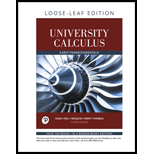
University Calculus: Early Transcendentals, Loose-leaf Edition (4th Edition)
4th Edition
ISBN: 9780135164860
Author: Joel R. Hass, Christopher Heil, Przemyslaw Bogacki, Maurice D. Weir, George B. Thomas Jr.
Publisher: PEARSON
expand_more
expand_more
format_list_bulleted
Concept explainers
Question
Chapter A.5, Problem 4E
To determine
To prove: That
Expert Solution & Answer
Want to see the full answer?
Check out a sample textbook solution
Students have asked these similar questions
the answer is Dcould you explain how using the curland also please disprove each option that is wrong
The correct answer is D
Could you please explain why
For number 4 the answer is B
Could you explain why
Chapter A.5 Solutions
University Calculus: Early Transcendentals, Loose-leaf Edition (4th Edition)
Knowledge Booster
Learn more about
Need a deep-dive on the concept behind this application? Look no further. Learn more about this topic, calculus and related others by exploring similar questions and additional content below.Similar questions
- For number 9 The answer is A Could you show me howarrow_forwardThe answer is B, Could you please show the steps to obtain the answerarrow_forward2. Suppose that U(x, y, z) = x² + y²+ z² represents the temperature of a 3-dimensional solid object at any point (x, y, z). Then F(x, y, z) = -KVU (x, y, z) represents the heat flow at (x, y, z) where K > 0 is called the conductivity constant and the negative sign indicates that the heat moves from higher temperature region into lower temperature region. Answer the following questions. (A) [90%] Compute the inward heat flux (i.e., the inward flux of F) across the surface z = 1 - x² - y². (B) [10%] Use the differential operator(s) to determine if the heat flow is rotational or irrotational.arrow_forward
- Could you show why the answer is B Using polar coordinates and the area formulaarrow_forward1. The parametric equations x = u, y = u cos v, z = usin v, with Ou≤ 2, 0 ≤ v ≤ 2π represent the cone that is obtained by revolving (about x-axis) the line y = x (for 0 ≤ x ≤2) in the xy-plane. Answer the following questions. (A) [50%] Sketch the cone and compute its surface area, which is given by dS = [ | Ər Or ди მა × du dv with S being the cone surface and D being the projection of S on the uv-plane. (B) [50%] Suppose that the density of the thin cone is σ(x, y, z) = 0.25x gr/cm². Compute the total mass of the cone.arrow_forwardThe value of sin (2V · F) at x = 3, y = 3, z = −4, where F -0.592 -0.724 0.661 -0.113 -0.822 -0.313 0.171 0.427 = (-2x² + -4,2yz − x − 3, −5xz - 2yz), isarrow_forward
- The correct answer is C Could you show me whyarrow_forwardThe graph of f(x) is given below. Select each true statement about the continuity of f(x) at x = -4. Select all that apply: ☐ f(x) is not continuous at x = -4 because it is not defined at x = −4. ☐ f(x) is not continuous at x = -4 because lim f(x) does not exist. x-4 f(x) is not continuous at x = -4 because lim f(x) = f(−4). ☐ f(x) is continuous at x = -4. x-4 ين من طلب نہ 1 2 3 4 5 6 7arrow_forwardThe graph of f(x) is given below. Select each true statement about the continuity of f(x) at x = -1. -7-6-5 N HT Select all that apply: ☐ f(x) is not continuous at x = -1 because it is not defined at x = -1. ☐ f(x) is not continuous at -1 because lim f(x) does not exist. x-1 ☐ f(x) is not continuous at x = -1 because lim f(x) = f(−1). ☐ f(x) is continuous at x = -1. x-1 5 6 7arrow_forward
arrow_back_ios
SEE MORE QUESTIONS
arrow_forward_ios
Recommended textbooks for you
 Calculus: Early TranscendentalsCalculusISBN:9781285741550Author:James StewartPublisher:Cengage Learning
Calculus: Early TranscendentalsCalculusISBN:9781285741550Author:James StewartPublisher:Cengage Learning Thomas' Calculus (14th Edition)CalculusISBN:9780134438986Author:Joel R. Hass, Christopher E. Heil, Maurice D. WeirPublisher:PEARSON
Thomas' Calculus (14th Edition)CalculusISBN:9780134438986Author:Joel R. Hass, Christopher E. Heil, Maurice D. WeirPublisher:PEARSON Calculus: Early Transcendentals (3rd Edition)CalculusISBN:9780134763644Author:William L. Briggs, Lyle Cochran, Bernard Gillett, Eric SchulzPublisher:PEARSON
Calculus: Early Transcendentals (3rd Edition)CalculusISBN:9780134763644Author:William L. Briggs, Lyle Cochran, Bernard Gillett, Eric SchulzPublisher:PEARSON Calculus: Early TranscendentalsCalculusISBN:9781319050740Author:Jon Rogawski, Colin Adams, Robert FranzosaPublisher:W. H. Freeman
Calculus: Early TranscendentalsCalculusISBN:9781319050740Author:Jon Rogawski, Colin Adams, Robert FranzosaPublisher:W. H. Freeman
 Calculus: Early Transcendental FunctionsCalculusISBN:9781337552516Author:Ron Larson, Bruce H. EdwardsPublisher:Cengage Learning
Calculus: Early Transcendental FunctionsCalculusISBN:9781337552516Author:Ron Larson, Bruce H. EdwardsPublisher:Cengage Learning

Calculus: Early Transcendentals
Calculus
ISBN:9781285741550
Author:James Stewart
Publisher:Cengage Learning

Thomas' Calculus (14th Edition)
Calculus
ISBN:9780134438986
Author:Joel R. Hass, Christopher E. Heil, Maurice D. Weir
Publisher:PEARSON

Calculus: Early Transcendentals (3rd Edition)
Calculus
ISBN:9780134763644
Author:William L. Briggs, Lyle Cochran, Bernard Gillett, Eric Schulz
Publisher:PEARSON

Calculus: Early Transcendentals
Calculus
ISBN:9781319050740
Author:Jon Rogawski, Colin Adams, Robert Franzosa
Publisher:W. H. Freeman


Calculus: Early Transcendental Functions
Calculus
ISBN:9781337552516
Author:Ron Larson, Bruce H. Edwards
Publisher:Cengage Learning
Polynomials with Trigonometric Solutions (2 of 3: Substitute & solve); Author: Eddie Woo;https://www.youtube.com/watch?v=EnfhYp4o20w;License: Standard YouTube License, CC-BY
Quick Revision of Polynomials | Tricks to Solve Polynomials in Algebra | Maths Tricks | Letstute; Author: Let'stute;https://www.youtube.com/watch?v=YmDnGcol-gs;License: Standard YouTube License, CC-BY
Introduction to Polynomials; Author: Professor Dave Explains;https://www.youtube.com/watch?v=nPPNgin7W7Y;License: Standard Youtube License